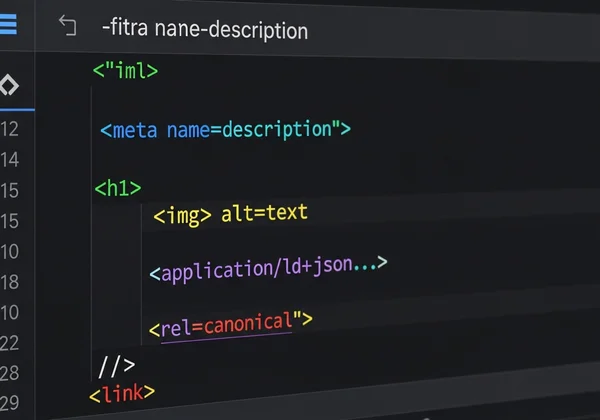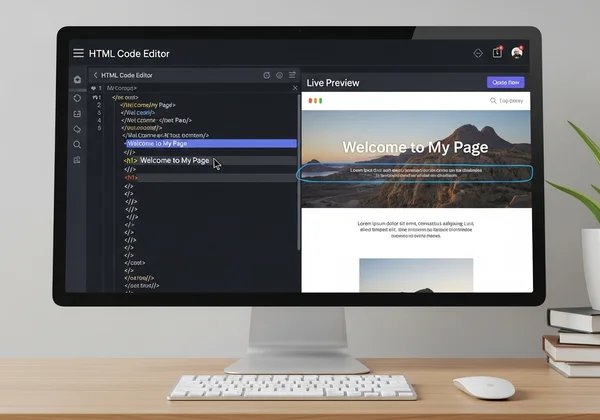Visualizador de HTML para Auditoria de SEO Técnico: Desvendando os Segredos do Site
Como profissional de SEO, passei inúmeras horas examinando códigos-fonte desorganizados e sem formatação, tentando decifrar a estratégia on-page de um site. É uma parte tediosa, mas essencial, de qualquer auditoria técnica. O verdadeiro desafio é a eficiência e a precisão. Então, como eu visualizo o código HTML de um site sem me perder em um emaranhado de tags? É aqui que um poderoso Visualizador de HTML se torna seu aliado mais valioso. Este guia mostrará como transformar seu processo de SEO técnico, tornando-o mais rápido e produtivo com as ferramentas online certas. Pare de lidar com as ferramentas de desenvolvedor do navegador e descubra uma maneira melhor de auditar com um visualizador fácil de usar.

Por Que as Auditorias de SEO Técnico Importam: Utilizando a Análise de HTML de URL
Uma auditoria de SEO técnico é a base de qualquer estratégia de otimização de busca bem-sucedida. É o processo de avaliar os aspectos técnicos do seu site para garantir que os mecanismos de busca possam rastrear, indexar e entender seu conteúdo efetivamente. Sem uma base técnica sólida, mesmo o melhor conteúdo pode falhar em ranquear. É por isso que dominar a análise de HTML de URL é fundamental para qualquer pessoa que leva a sério a melhoria do desempenho do seu site nos resultados de busca. Ela permite que você veja seu site exatamente como um rastreador de mecanismo de busca o faz.
O Que É uma Auditoria de SEO Técnico e Por Que É Crucial para o Ranqueamento?
Uma auditoria de SEO técnico envolve a verificação da saúde do seu site para encontrar e corrigir problemas que podem estar prejudicando seus ranqueamentos. Isso inclui examinar tudo, desde a velocidade do site e a compatibilidade com dispositivos móveis até sitemaps e, o mais importante, o código HTML subjacente das suas páginas. HTML limpo e bem estruturado é um sinal de um site de alta qualidade para o Google. Problemas como meta tags ausentes, estruturas de cabeçalho inadequadas ou Schema Markup inválido podem limitar severamente sua visibilidade orgânica. Uma auditoria completa revela esses segredos, fornecendo um roteiro claro para melhorias.
Como Importar uma URL e Visualizar Seu Código-Fonte HTML Bruto Instantaneamente?
Tradicionalmente, visualizar o código-fonte de uma página significava clicar com o botão direito e selecionar "Exibir Código-Fonte da Página" ou lidar com as ferramentas de desenvolvedor do navegador. Embora funcional, a saída é frequentemente uma parede de texto compactada e ilegível. Uma abordagem moderna é usar uma ferramenta dedicada. Com um visualizador de HTML online, você simplesmente cola a URL do site, e ele busca instantaneamente o HTML bruto. Este passo simples economiza tempo e fornece um ponto de partida limpo para sua análise. Este processo é o primeiro passo para realmente entender como visualizar o código-fonte HTML de forma eficaz e sem frustração.
Melhorando a Legibilidade: Por Que Formatar o Código-Fonte HTML É Essencial para Auditorias
Este é o divisor de águas. O HTML bruto, especialmente de sistemas de gerenciamento de conteúdo complexos, é frequentemente minificado — todos os espaços em branco, quebras de linha e comentários são removidos para economizar espaço. Embora ótimo para o desempenho, é um pesadelo para a análise humana. É aqui que um formatador de HTML entra em ação. Com um único clique, ele transforma aquela linha de código bagunçada em um documento perfeitamente indentado e fácil de ler. Essa formatação permite que você escaneie rapidamente elementos-chave, identifique problemas estruturais e analise o código sem forçar a vista. Torna todo o processo de auditoria mais preciso e muito menos doloroso.

Analisando o Código-Fonte do Site do Concorrente: Uma Vantagem Estratégica
Além de auditar seu próprio site, analisar o código-fonte do site do seu concorrente é uma tática de pesquisa poderosa. É como ter um vislumbre dos bastidores da estratégia de SEO on-page deles. Ao examinar o HTML deles, você pode fazer engenharia reversa do que eles estão fazendo certo, identificar o foco de suas palavras-chave e encontrar oportunidades para superá-los. Uma visualização limpa e formatada do código deles torna essa análise incrivelmente eficiente. Você pode começar com uma ferramenta poderosa hoje.
Como Identificar Elementos Críticos de SEO On-Page, como Meta Tags e Estrutura de Cabeçalhos?
Depois de ter o HTML formatado à sua frente, você pode encontrar rapidamente os elementos on-page mais importantes. Procure a tag <title> e a tag <meta name="description"> para ver suas palavras-chave primárias e o pitch para o usuário. Em seguida, escaneie a estrutura de cabeçalhos: tags <h1>, <h2> e <h3>. Isso revela a hierarquia de conteúdo deles e mostra quais subtópicos eles estão enfatizando. Uma estrutura de cabeçalhos lógica é crucial tanto para a experiência do usuário quanto para a compreensão dos mecanismos de busca, e analisá-la é uma parte central de qualquer auditoria.
O Que Procurar: Schema Markup, Texto Alternativo e Tags Canônicas
Aprofundar-se no código revela táticas de SEO mais avançadas. Procure por Schema Markup (geralmente começando com application/ld+json) para ver se eles estão usando dados estruturados para obter rich snippets nos resultados de busca. Verifique as tags <img> para texto alternativo descritivo, que é vital para o SEO de imagens e acessibilidade. Finalmente, procure a tag rel="canonical" para entender como eles lidam com conteúdo duplicado. Encontrar esses elementos em código bruto e sem formatação pode ser como procurar uma agulha num palheiro; com uma visualização formatada, eles se destacam claramente. Você pode visualizar o código-fonte online sem esforço para identificar esses detalhes.

Analisando a Estrutura do Conteúdo e Estratégias de Links Internos com a Visualização de HTML
A estrutura HTML conta uma história sobre o conteúdo de uma página e a distribuição de autoridade. Ao observar a ordem do conteúdo e o posicionamento dos links internos dentro do código, você pode obter insights sobre a estratégia de um concorrente. Eles estão linkando para suas páginas mais importantes a partir do conteúdo principal do corpo? Como eles estão estruturando sua navegação e rodapés? Analisar a visualização de html fornece um projeto da arquitetura do site deles e do link building interno, ajudando você a construir uma estratégia mais forte para seu próprio site.
Visualizador de HTML: Sua Ferramenta Essencial de SEO para Auditorias de Sites
Para auto-auditorias e análises de concorrentes, ter uma ferramenta confiável de visualizador de HTML para SEO é essencial. Uma ótima ferramenta vai além de simplesmente exibir o código; ela otimiza todo o seu fluxo de trabalho. Ela deve permitir que você importe de uma URL, formate o código para legibilidade e até mesmo o edite para testar possíveis alterações. Isso transforma uma tarefa complexa e demorada em um processo simplificado e eficiente. Um editor de html online integra todas essas funções em uma plataforma acessível.
Além da Visualização Básica: Dicas Avançadas para Profissionais de SEO
Depois de se sentir confortável com o básico, você pode usar um visualizador de HTML para tarefas mais avançadas. Use-o para identificar excesso de código (code bloat) — scripts desnecessários, CSS inline excessivo ou tags redundantes que diminuem o tempo de carregamento da página. Você também pode verificar rapidamente se um site está usando tags semânticas modernas do HTML5, como <article>, <section> e <nav>, que fornecem um contexto melhor para os mecanismos de busca. Esse nível mais profundo de análise ajuda você a identificar problemas de desempenho que outras ferramentas podem perder.
Os Benefícios de um Editor de HTML Online para Monitoramento Contínuo de SEO
SEO não é uma tarefa única; exige monitoramento contínuo. Um editor de HTML online com um recurso de visualização ao vivo é perfeito para isso. Se você suspeitar que um elemento on-page precisa de ajustes, você pode colar o HTML da página, fazer suas alterações diretamente no editor e ver o resultado visual em tempo real. Isso permite que você experimente novas tags de título, cabeçalhos ou estruturas de conteúdo antes de enviar as alterações ao vivo. É um ambiente seguro de testes para otimizar suas páginas e uma ferramenta inestimável para a melhoria contínua. Experimente este editor para ver a diferença.

Eleve Suas Auditorias de SEO Técnico com o Visualizador de HTML
Pare de perder tempo tentando decodificar um código-fonte bagunçado. Uma auditoria de SEO técnico simplificada começa com uma visualização clara e legível do HTML de um site. Ao aproveitar os recursos de importação de URL e formatação de uma ferramenta dedicada, você pode conduzir auditorias mais rápidas e precisas e obter uma vantagem estratégica significativa. Quer esteja analisando seu próprio site ou espionando concorrentes, a ferramenta certa o capacita a descobrir segredos ocultos e a construir um roteiro para o sucesso nos ranqueamentos. Pronto para transformar seu fluxo de trabalho? Comece sua auditoria agora e veja o que você pode descobrir.
Perguntas Frequentes Sobre HTML e Auditorias de SEO
Como visualizo o código HTML de qualquer site facilmente?
A maneira mais fácil é usar uma ferramenta online como o Visualizador de HTML. Em vez de lidar com menus de navegador confusos, você pode simplesmente colar a URL do site na ferramenta. Ela busca instantaneamente o HTML completo e, com um clique no botão "Formatar", o transforma em um documento limpo e perfeitamente formatado que é fácil de ler e analisar.
O que é um Visualizador de HTML e como ele pode ajudar meu SEO?
Um Visualizador de HTML é uma ferramenta que exibe o código subjacente de uma página da web. Para SEO, é inestimável porque permite realizar uma auditoria técnica detalhada. Você pode inspecionar facilmente elementos on-page críticos, como tags de título, meta descrições, estruturas de cabeçalho, Schema Markup e texto alternativo para garantir que estejam devidamente otimizados para os mecanismos de busca.
Posso pré-visualizar uma página HTML que editei online?
Sim, uma característica chave de uma ferramenta de qualidade é a pré-visualização em tempo real. Ao editar o código HTML no painel do editor, você pode ver instantaneamente como essas alterações ficarão em uma página da web ao vivo no painel de pré-visualização. Essa funcionalidade "o que você vê é o que você obtém" é perfeita para testar alterações na estrutura da página ou no conteúdo antes da implementação. Pré-visualize seu html com nossa ferramenta.
O Visualizador de HTML é adequado para auditorias abrangentes de SEO técnico?
Absolutamente. Embora uma auditoria abrangente envolva muitas ferramentas, o Visualizador de HTML é um ponto de partida essencial para todas as análises de on-page e código-fonte. Sua capacidade de importar de uma URL e formatar instantaneamente o código o torna uma das ferramentas mais eficientes para verificar meta tags, cabeçalhos, Schema Markup e muito mais. Ele simplifica a parte fundamental da sua auditoria, permitindo que você se concentre na estratégia.